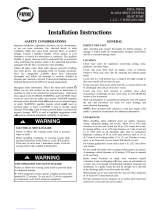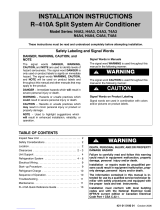
INST ALLATION INSTRUCTIONS R- 410A Split System Air Conditioner
421 01 5103 05 15
Specifications subject to c hange without notice.
Replace stem caps after system is opened to
refrigerant flow. Replace c aps finger- tight and tighten
with wrench an additional 1/12 turn
3. Close electrical disconnects to energize system.
4. Set room thermostat at desired temperature. Be sure
set point is below indoor ambient temperature.
5. Set room thermostat to COOL and fan control to ON or
AUTO mode, as desired. Operate unit for 15 minutes.
Check system refrigerant charge.
Check Charge
Factory charge amount and desired subcooling are shown
on unit rating plate. Charging method is shown on information
plate inside unit. To properly check or adjust charge,
conditions must be favorable for subcooling charging.
Favorable conditions exist when the outdoor temperature is
between 70_F and 100_F (21.11_C and 37.78_C), and the
indoor temperature is between 70_F and 80_F (21.11_C and
26.67_C). Follow the procedure below:
Unit is factory charged for 15ft (4.57 m) of lineset. Adjust
charge by adding or removing 0.6 oz/ft of 3/8 liquid line
above or below 15ft (4.57 m) respectively.
For standard refrigerant line lengths (80 ft/24.38 m or less),
allow system to operate in cooling mode at least 15 minutes.
When operating with the Observer Wall Control in
communicating mode, make sure that indoor airflow is set to
“efficiency” during charging. If conditions are favorable, check
system charge by subcooling method. If any adjustment is
necessary, adjust charge slowly and allow system to operate
for 15 minutes to stabilize before declaring a properly
charged system.
If the indoor temperature is above 80_F (26.67_C), and the
outdoor temperature is in the favorable range, adjust system
charge by weight based on line length and allow the indoor
temperaturetodropto80_F (26.67_C) before attempting to
check system charge by subcooling method as described
above.
If the indoor temperature is below 70_F (21.11_C), or the
outdoor temperature is not in the favorable range, adjust
charge for line set length above or below 15ft (4.57 m) only.
Charge level should then be appropriate for the system to
achieve rated capacity. The charge level could then be
checked at another time when the both indoor and outdoor
temperatures are in a more favorable range.
NOTE: If line length is beyond 80 ft (24.38 m) or greater than
20 ft (6.10 m) vertical separation, See Long Line Applications
Guideline for special charging requirements.
Major Components
Control Board
The AC control board controls the following functions:
S Compressor contactor operation
S Outdoor fan motor operation
S Compressor external protection
S Pressure switch monitoring
S Time Delays
Field Connections
When using communicating control, 4 field wires are required
to be connected to the factory wires already wired to the
DX+DX- C R terminal (see Fig. 20). Unit as provided by
manufacturer is set up for communicating control.
When used with a standard non- communicating thermostat,
it is recommended to use 3 thermostat control wires to be
connected to R, Y and C. When using 3 wires, all diagnostic
and time delay features are enabled (See Fig. 21).
Disconnect factory provided wires from DX+, DX- , C & R
terminals. Using factory provided wires, connect to R, C, and
Y on the control board for 3 wire thermostat control. Connect
field 24V wires to factory provided wires now connected to R,
C, and Y and cap both sides or remove unused factory
provided wires.
When only 2 thermostat control wires are available, units will
function, but some control features are lost. (See Fig. 22).
With only 2 wires connected, the circuit board will be
powered down whenever there is no call for cooling, and the
following will result:
S Compressor time delay is reduced from 5 minutes to 10
seconds
S When the thermostat is not calling for cooling, the amber
status light will be off, and no diagnostics codes will be
available
S All system counters will be reset on each new call for
cooling
Disconnect factory provided wires from DX+, DX- , C and R
terminals. Using factory provided wires, connect to C and Y
on the control board for 2 wire thermostat control. A field
installed jumper wire is also required between R and Y (See
Fig. 22). Connect field 24V wires to factory provided wires
now connected to C and Y and cap both sides or remove
unused factory provided wires.
Compressor Internal Relief
The compressor is protected by an Internal Pressure Relief
(IPR) which relieves discharge gas into the compressor shell
when differential between suction and discharge pressure
exceeds 550- 625 psi. The compressor is also protected by
an internal overload attached to motor windings.
GENERAL SEQUENCE OF OPERATION
STANDARD THERMOSTAT
Turn on power to indoor and outdoor units. Transformer is
energized.
On a call for cooling, thermostat makes circuits R- Y and
R- G. Circuit R- Y energizes contactor, starting outdoor fan
motor and compressor circuit. R - G energizes indoor unit
blower relay, starting indoor blower motor on high speed.
NOTE: To achieve the rated system performance, the indoor
unit or the thermostat must be equipped with a time delay
relay circuit.
When thermostat is satisfied, its contacts open,
de- energizing contactor and blower relay. Compressor and
motors stop. If indoor unit is equipped with a time- delay relay
circuit, the indoor blower will run an additional 90 sec to
increase system efficiency.
CONTROL FUNCTIONS
AND SEQUENCE OF OPERATION
The outdoor unit control system has special functions. The
following is an overview of the control functions.
SEQUENCE OF OPERATION
Cooling Operation
This product utilizes either a standard indoor thermostat or
Observer t Communicating Wall Control. With a call for
cooling, the outdoor fan and compressor are energized.
When the cooling demand is satisfied, the compressor and
fan will shut off.
NOTE: The outdoor fan motor will continue to operate for one
minute after compressor shuts off, when the outdoor ambient
is greater than or equal to 100_F (37.78_C).





















